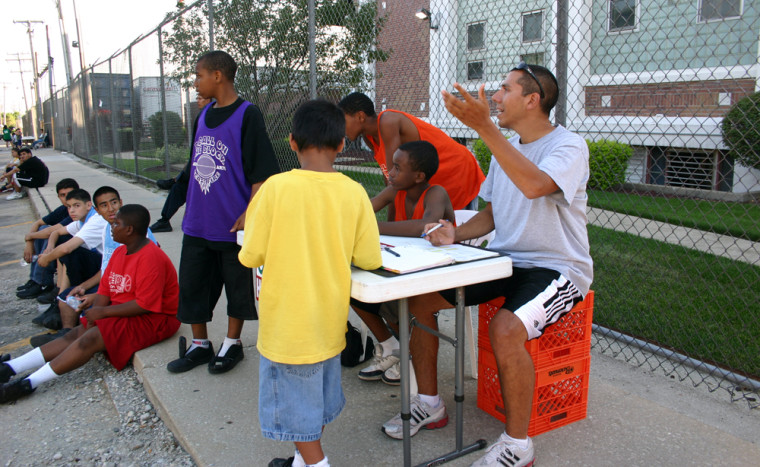If somebody tried to burn your house down — not once, but twice in the last eight years — you might think that the neighborhood was not a good match for you, right?
Rob Castaneda and his wife, Amy, don’t feel that way. They have faced gang violence, literally at their front door, and after 10 years, remain ensconced in their two-story home in Chicago’s Little Village neighborhood, home to the largest Mexican-American population in the Midwest and the East-West dividing line between two gangs, the Latin Kings and the Two-Six.
So why is this 34-year-old couple still living in Little Village? Mostly, says Rob, it was time to take a stand. “Most of the people who live in these [types of] communities are honest, hard-working people who live in fear — so they just turn their heads,” says Rob. “My head doesn’t turn very easily.”
No kidding. Castaneda, a third-generation Mexican-American, discovered early on that he could be a force for change in his gang-riven community — simply by staying put and using his coaching skills (and a school basketball court) to teach the neighborhood’s youth a new way to interact.
Today, some seven years later, that determination has evolved into Beyond the Ball, a local nonprofit he started in 2006 with his wife to prepare urban youth to be community leaders through athletic programs, tutoring, mentoring, and youth leadership training.
Gang turf
But getting to that point has been a difficult — and often dangerous — journey. It all began in December 1998, when Rob and Amy moved into the neighborhood so Amy could start teaching at one of the local schools. Both had grown up locally, Rob in marginalized South Chicago and Amy in working-class McKinley Park, about a half-mile from Little Village. They were high school sweethearts and went to college together in South Carolina. In 1996, they were wed.
“The first year that we lived [in Little Village], almost every day, sometimes twice a day, there could be between three and 20 guys hanging out in front of our house,” Rob recalls. “These guys could be shooting, or throwing bottles at cars. They were trying to draw out rival gang members driving down the street.”
Then, one January night in 2000, Rob was awakened by the sound of gunfire and called the police. Just before they arrived, Castaneda saw one of the gang members hide a gun behind the license plate of a nearby car and run off. Watching from the house, Castaneda became frustrated waiting for the officers to find the weapon and so opened his door, went out to the street, and showed them where to look.
Gang retribution came swiftly. Several nights later, the Castaneda’s porch was set ablaze, and Rob had to put it out, himself, with a towel. Later that night, Rob recalls, the couple discussed moving to the suburbs. But they changed their minds the next day when members of the girl’s basketball team visited the house and begged them to stay. One girl told Amy: “You’ can’t leave, because if you do, who’s going to help us?”
Two weeks later, though, it happened again. Gang members threw a Molotov cocktail through the Castaneda’s front window, setting their porch and front door ablaze once more. But this time, Rob and Amy decided to fight back. The fire department came to extinguish the fire; the Castanedas alerted the media, the local police set up a security detail and, ultimately, neighbors organized a march through the neighborhood.
The day of the march, the principal of a neighborhood middle school (located near the geographical dividing line separating one gang territory from the other) met the couple, and later that summer offered Amy a job teaching art at his school. Rob inquired about coaching in the fall, and was accepted. For the next few months, Rob worked to quell the gang activity against heavy odds. Sometimes, he recalls, students would ask to stay late — just so they could avoid being confronted by gang “recruiters” on their way home from school. Making matters worse? There was no indoor basketball court, no safe place where players could simply be themselves and focus on the game.
Recruiting players, not gang members
Then Rob got an idea. He persuaded the school principal to open the school gym on Saturdays and began hosting pick-up games there. Soon, players began asking Rob if they could add their brother or cousin or friends to the teams, and before long, Castaneda’s Saturday games were attracting up to 70 players of all ages, races, and gang allegiances. Eventually, he formed a neighborhood basketball league. As of this past summer, the league had four divisions and 196 players — male and female.
But managing it all wasn’t easy. “Sometimes,” Castaneda said, “we’d have guys who would come into the gym and try to get up in people’s faces to talk about gang stuff, but just as often, somebody would say to them, ‘You can’t do that stuff in here, you have to leave it outside.’” Recalls Rob: “[The players] had started forming these amazing relationships. [We had] black players and Latino players and in five years, there was not one fight.”
Little Village still has gang problems but not like the ones it had when the Castanedas moved in. “[Some of] these guys are coming to my house now. We’re watching basketball games on my TV, we’re eating dinner together. [Beyond the Ball] isn’t just a program anymore. It’s our way of life,” he says.
Just ask Amy Castaneda’s mother, Connie Puga. “Without Rob and Amy,” she says, “these [neighborhood] kids would have nothing” — proof, again, that it takes a village. Literally.
